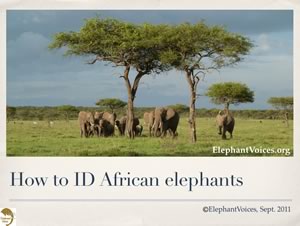Mara Elephants Who's Who & Whereabouts
 Identifying elephants isn't difficult, but it requires using powers of observation and it takes a bit of practice. There are many different characteristics that you can use to identify an elephant: sex; body size; shape; length and configuration of the tusks; size and shape of the ears; ear venation patterns; notches, tears, holes in the ears. ElephantVoices has developed eight educational modules explaining how to read and understand these characteristics, also used in the Mara Elephants Who's Who database.
Identifying elephants isn't difficult, but it requires using powers of observation and it takes a bit of practice. There are many different characteristics that you can use to identify an elephant: sex; body size; shape; length and configuration of the tusks; size and shape of the ears; ear venation patterns; notches, tears, holes in the ears. ElephantVoices has developed eight educational modules explaining how to read and understand these characteristics, also used in the Mara Elephants Who's Who database.
You should start by determining whether the elephant you are trying to identify is male or female, and will get help from How to sex African Elephants.
Over time the ears of elephants may develop a wide variety of notches, tears and holes. And each ear has a unique pattern of veins that (in a good photo) are visible on its surface. These patterns are a very useful feature, particularly when two elephants are otherwise very alike. You can use a combination of these characteristics to ID an elephant.
The edges of the ears of elephants may be smooth or have any number of size and shape notches out of them, which together create a unique pattern. The notches and tears are caused by wear and tear, though elephants with thicker ears seem to be less prone to damage.
In order to use the database effectively you need to know what terms we use to refer to the many different types of tears, notches and holes.
By clicking on the screenshot to the right, or on one of the links to photos below, you will start a slideshow. The caption shown is equal to respective text on this page. You can go through slide by slide - or let it run through automatically. Learn more about elephants - enjoy!
What to look for when using ear notches and tears to identify African elephants
- The edges of an elephant's ear may be "completely smooth". Photo D1
- Or it may be "smooth with tiny nicks" or notches. Photo D2
- An ear with many tiny or small nicks and notches is "serrated". Photo D3
- Another example of "serrated". Photo D4
- While one with numerous medium and larger notches and tears is "ragged". Photo D5
- A "V-notch" is shaped like a V. Photo D6
- A "U-notch" is shaped like a U. Photo D7
- A "cup-notch" is shaped like a tea-cup - rounded but more shallow than a U-notch. Photo D8
- A "dip-notch", like a dip in the road, is even shallower than a cup-notch. Photo D9
- A "scoop-notch" is a wide scoop out of the ear - deeper than a dip but shallower than a cup and wider than both. Photo D10
- A "square-notch" has sharper edges, like a square. Photo D11
- A "wedge" is a triangular notch out of the ear, with one side longer than the other. Photo D12
- A "finger-flap" is a little finger like flap that sticks out from the edge of the ear - usually apparent when there are shallow notches on either side. Photo D13
- A "flap-cut" is a tear in the ear where a flap of skin remains hanging down. Photo D14
- An "outstanding notch or tear" is a really obvious rip or tear in the ear that really stands out and makes the elephant very easy to identify. Photo D15
- Another example of an "outstanding notch or tear". Photo D16
- Elephants often get holes in their ears. They may have only one "hole", Photo D17, or:
- "two or more holes". Photo D18
- Here's another example of "two or more holes". Photo D19
- Holes may also be elongated and are called "slit-holes". Photo D20
- Some ears have very "prominent veins" that are useful as identifying features. Photo D21
- An elephant may have a "damaged ear", perhaps caused by a fight with another elephant. Photo D22
- Or elephants may have a "flop ear". Photo D23
- Here is another example of "flop ear". Photo D24
- Some elephants "have droopy ears". Photo D25
- While still others may have a crease or "fold ear". Photo D26


